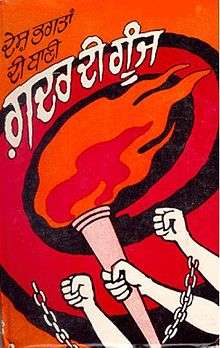Rowlatt Committee
The Rowlatt Committee was a Sedition Committee appointed in 1917 by the British Indian Government with Sidney Rowlatt, an English judge, as its president.
Background
The purpose of the Rowlatt Committee was to evaluate political terrorism in India,[1] especially in the Bengal and Punjab Provinces, its impact, and the links with the German government and the Bolsheviks in Russia.[2][3] It was instituted towards the end of World War I when the Indian revolutionary movement had been especially active and had achieved considerable success, potency and momentum and massive assistance had been received from Germany, which planned to destabilise British India.[4] These included supporting and financing Indian seditionist organisations in Germany and in United States as well as a destabilisation in the political situation in neighbouring Afghanistan following a diplomatic mission that had attempted to rally the Amir of Afghanistan against British India. Attempts were also made by the Provisional Government of India established in Afghanistan following the mission to establish contacts with the Bolsheviks. A further reason for institution of the committee was emerging civil and labour unrest in India around the post-war recession - such as the Bombay mill worker's strikes and unrest in Punjab - and the 1918 flu pandemic that killed nearly 13 million people in the country.[5]
The evidence produced before the committee substantiated the German link, although no conclusive evidence was found for a significant contribution or threat from the Bolsheviks. On the recommendations of the committee, the Rowlatt Act, an extension of the Defence of India Act 1915, was enforced in response to the threat in Punjab and Bengal.[2]
The Rowlatt Act had a significant impact on the political situation of India, irrevocably placing the country on a path of political action headed by Gandhi that ultimately dominated the Indian independence movement for the next 20 years. Also known as the Black Act, it vested the Viceroy's government with extraordinary powers to quell sedition by silencing the press, detaining the political activists without trial, and arresting without warrant any individuals suspected of sedition or treason. In protest, a nationwide cessation of work (hartal) was called, marking the beginning of widespread, although not nationwide, popular discontent.
The agitation unleashed by the acts culminated on 13 April 1919, in the Jallianwala Bagh massacre in Amritsar, Punjab when the British military commander, Brigadier-General Reginald Dyer, blocked the main entrance to the Jallianwallah Bagh, a walled-in courtyard in Amritsar, and ordered his soldiers to fire into an unarmed and unsuspecting crowd of some 6,000 people who had assembled there in defiance of a ban. A total of 1,650 rounds were fired, killing 379 people (as according to an official British commission; Indian estimates ranged as high as 1,500[6]) and wounding 1,200 in the episode, which dispelled wartime hopes of home rule and goodwill in a frenzy of post-war reaction.
Committee members
- Sidney Rowlatt - President
- J. D. V. Hodge - Secretary (a member of the Bengal Civil Service)
- Basil Scott - Member (Chief Justice of the Bombay High Court)
- C. V. Kumaraswami Sastri - Member (judge of Madras High Court)
- Verney Lovett - Member (member of Board of Revenue for United Provinces)
- P. C. Mitter - Member (member of Bengal Legislative Council)
See also
References
Citations
- "The Rowlatt Committee". The Hindu. 6 April 2018. ISSN 0971-751X. Retrieved 26 January 2020.
- Tinker (1968), p. 92
- Leonard A. Gordon (February 1968). "Portrait of a Bengal Revolutionary". The Journal of Asian Studies. 27 (2): 197–216. doi:10.2307/2051747. JSTOR 2051747.
- Collett (2007), p. 218
- Chandler & Wright (2001), p. 179
- Ackerman, Peter, and Duvall, Jack, A Force More Powerful: A Century of Nonviolent Conflict p. 74.
Bibliography
- Tinker, Hugh (October 1968), "India in the First World War and after. 1918-19: From War to Peace.", Journal of Contemporary History, 3 (4): 89–107, doi:10.1177/002200946800300407, ISSN 0022-0094.
- Collett, Nigel (2007), The Butcher of Amritsar: General Reginald Dyer (New ed.), Hambledon & London, ISBN 978-1-85285-575-8.
- Chandler, Malcolm; Wright, John (2001), Modern World History., Heinemann Educational Publishers. 2nd Review edition, ISBN 978-0-435-31141-4
Further reading
- Elam, J. Daniel; Moffat, Chris (2016). "On the Form, Politics and Effects of Writing Revolution". South Asia: Journal of South Asian Studies. 39 (3): 513–524. doi:10.1080/00856401.2016.1199293.
